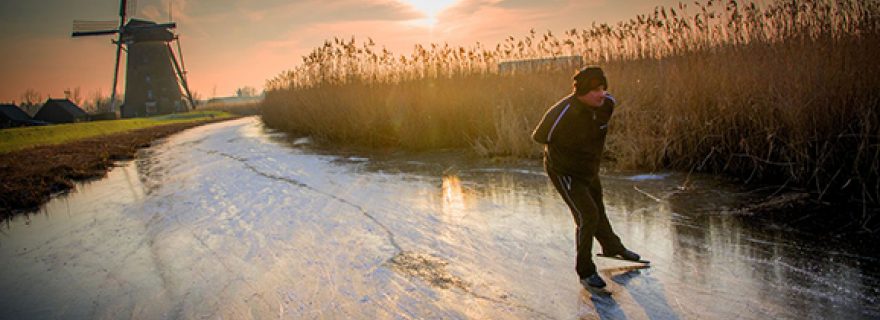Why can’t some people resist skating on thin ice?
Whenever we have a cold snap, people venture onto the ice - sometimes with disastrous results if they fall through. But why do some people take that risk of skating on thin ice?
Last week, the Dutch took to the ice in great numbers, making the most of the frozen canals and smaller waterways. Hundreds of volunteers did their bit to optimize the natural ice rinks all over the Netherlands.
It is always extremely dangerous to venture onto the ice at the beginning of the freeze and when the ice starts thawing. The website of the Royal Dutch Skating Association (KNSB) provides extensive information about ice safety. And yet many people still do take to the ice, even in these dangerous periods. On Sunday 4th March, when the thaw had set in, the police and fire brigades all over the country warned about the poor condition of the ice, and several people did indeed fall through. So what leads people to take such huge risks? Is skating on natural ice just so exhilarating that Dutch people are prepared to risk their lives for it?
Taking risks
Psychological research shows that certain circumstances contribute to people’s willingness to take risks. Impulsive people are more inclined to take risks than less impulsive people, for instance. Research has shown that if people are urged to respond to images quickly they take more risks that if they are encouraged to reflect carefully about their response. It turns out that impulsive people view risky situations differently. They see something, have a positive response to it, and then focus all their attention on it. This focused attention makes the temptation even more attractive in their eyes.
Thinking of God
Impulsivity aside, other research has shown that thinking of God also leads people to take more risks. In this experiment, participants were asked to choose between focusing on a dark, harmless block of colour or on a block of a colour that was so bright it might damage their eyesight; the latter choice would earn them a small financial reward. Immediately before choosing, some of the participants were guided to think of God: they read a passage about God or did a puzzle involving clues that related to God. The results showed that many more people were prepared to take the risk of focusing on the potentially dangerous colour if they had just thought about God than if they had not thought about God. The research indicated that people who had God in mind viewed risky behaviour as less dangerous, which suggests that they believed that God would protect them from danger.
Risk-taking in a group
Psychology research has also shown that people take more risks when they’re in a group than when they’re alone. This phenomenon is also known as a risky shift. In a group, people with relatively moderate views often think the other members of their group have more extreme views, and this frequently prompts them to adopt a more extreme stance themselves. Many studies show that in groups people are less conservative, take more risks, and experiment more than individuals acting alone.
And finally, some age groups are particularly prone to taking risks. Adolescents, for instance, take more risks than any other age group. Their risk of injury or death is even 200% higher than younger individuals. Adolescents are also more likely than adults to contract sexually transmitted diseases, often drive faster, and are more often involved in criminal activities. Studies have shown that the brain regions involved in inhibition and controlled behaviour are not yet properly developed in adolescents, which is why they are more likely to make short-term decisions, take risks, and behave impetuously.
Risky behaviour
All of these personality characteristics and circumstances contribute to that decision about whether or not to risk venturing onto the ice. And of course we shouldn’t forget that it’s just downright enjoyable to stand on the ice and enjoy the traditional delights of steaming hot chocolate or warming pea soup. But it would be good to make people more aware of these factors that influence risky behaviour, so that there may be fewer serious accidents and people can enjoy the ice more safely.
Read the original (Dutch) article in NRC: 'Waarom sommige mensen door het ijs zakken, en anderen niet'


